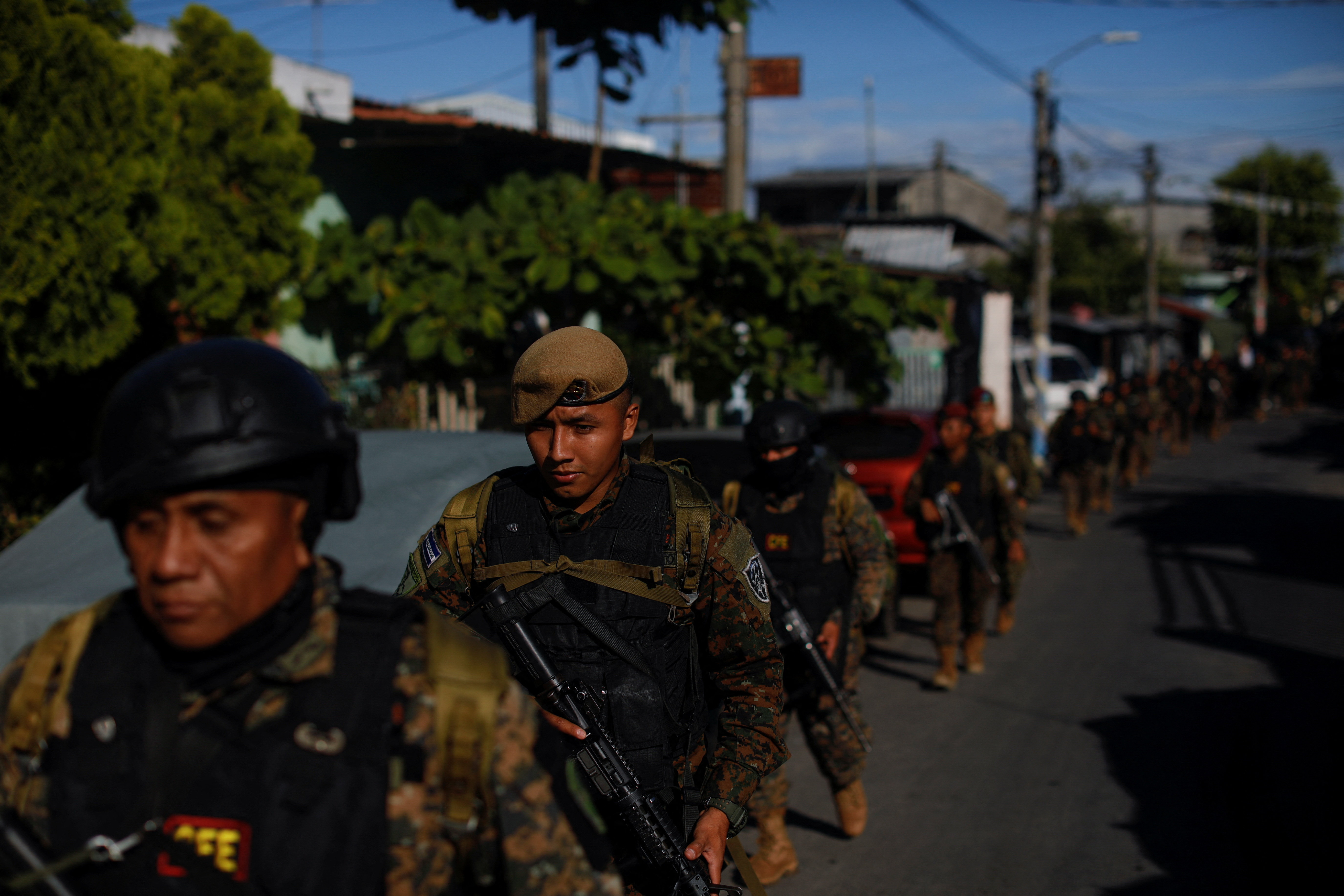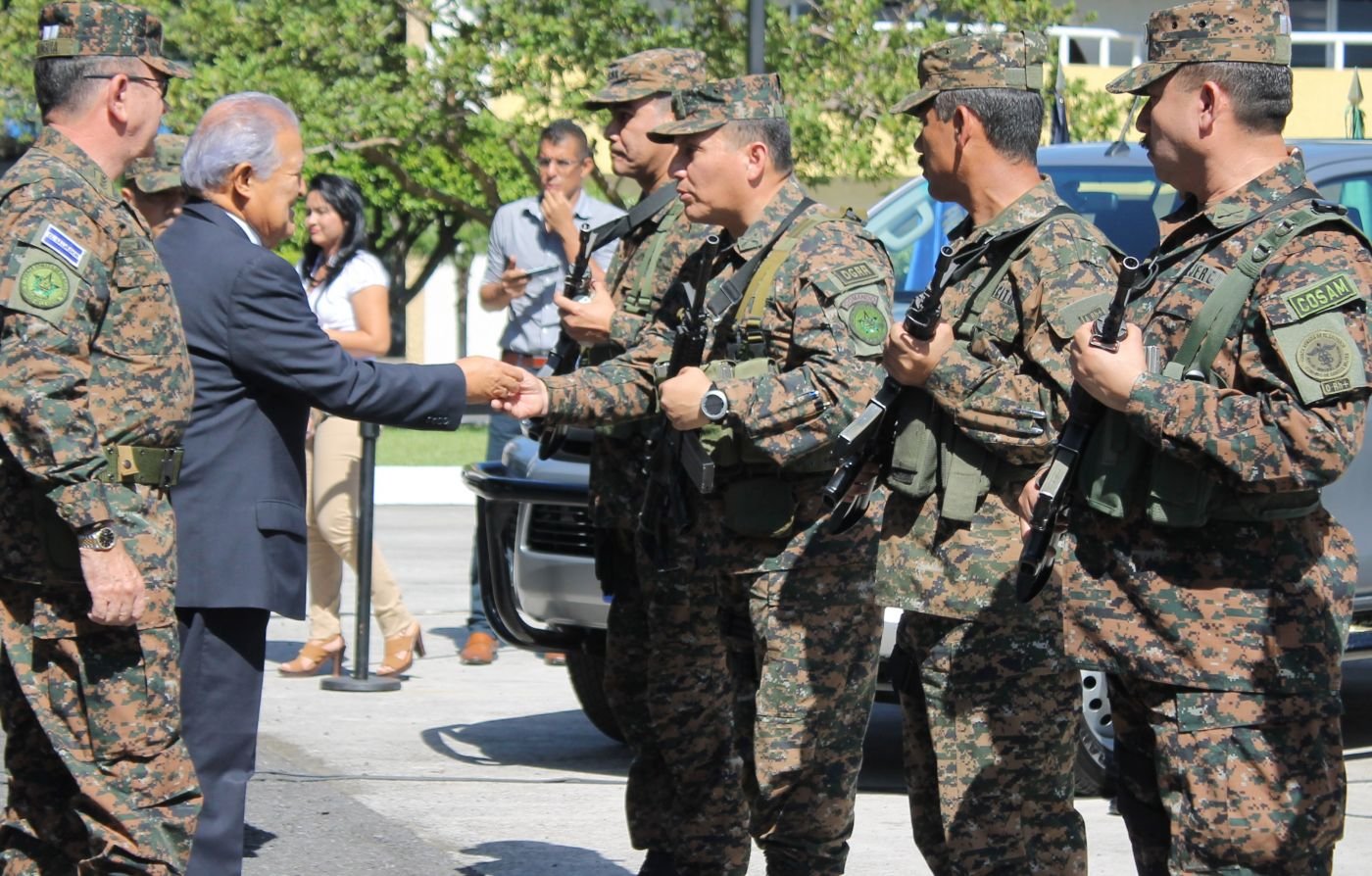Salvadoran Military - 1 / 2 Show Caption + Hide Caption - El Salvador Commando Sgt. Maj. Santos Serranos, center, discusses the uniform insignia with Salvadoran senior enlisted advisor, Command Sgt. Major. Carlos Olvera, right, of the U.S. Southern Command Sergeant Major, during the third day of the US/L salvo... (Photo credit: U.S. ) View Original
2 / 2 Show Caption + Hide Caption – Salvadoran Brig. Gen. William Armando Mejia, Salvadoran commanding officer, explains to Maj. Gen. Clare the equipment used by a Salvadoran soldier assigned to Task Force Mart, an anti-crime unit assigned to assist the Salvadoran police force... ( Photo credit: U.S. ) View original
Salvadoran Military

SAN SALVADOR, El Salvador (July 27, 2015) -- US South, as the service component command for US Southern Command, on behalf of the Commander in Chief, held staff talks with Salvadorans in San Salvador, El Salvador, July 13-16, to foster bilateral partnership to address transnational organized threats. Discuss ways to combat and plan mutual training engagements over the next three years to promote increased interaction between the United States and El Salvador's armed forces.
El Salvador: Deployment Of Security Forces In The Legislative Assembly Raises Alarm Over The Future Of Human Rights
"Our armies have a close and mutually beneficial relationship based on friendship and trust, which we have continued to strengthen over the years," said Major General K.K. Chin, US Southern Command and Head of US Mission.
Over the past year, staff officers from each have met in steering sessions to plan future engagements between the two forces. During senior engagement sessions, the leaders of each delegation meet to sign a memorandum of understanding that outlines the agreed upon activities or ATAs, subject matter experts and academic commitments.
Executive meetings where staff speak allow participants to share experiences, update and strengthen knowledge to combat drug trafficking, money laundering, illegal people and arms trafficking that affect the security of their respective countries.
During the three days of talks, the two delegations drew up a list of approximately 20 ATAs, which include a range of professional exchanges designed to enhance capabilities and the working relationship between the two forces.
Msas Launches Inaugural Wps Seminar In El Salvador > 18th Air Force > Article Display
During last year's staff briefing, there was a major discussion about the creation of a regional center of excellence to counter transnational threats. One way for both militaries to make progress against these threats is to create a regional training center to combat transnational crime. The facility, located in El Salvador, will serve as a teaching and training base and will be available to all Central American countries to develop capabilities to combat these threats.
The target is to make the center operational by 2016. Under current guidelines, El Salvador will facilitate infrastructure with South support, while the United States will develop a teaching program for El Salvador and conduct instructor transitions.
This year is notable for the strengthening of the Salvadoran Fusion Cell, which supports the special forces, the Comando de Montano and the Grupo Cuscatlán de la Salvadoran. The purpose of strengthening the cell is to increase its analytical capacity and effectiveness in support of the fight against emerging threats in the region.

In addition, Mejia gave the U.S. delegation a presentation of the El Salvadoran Anti-Crime Unit, which works to assist the El Salvadoran Civil Police Force, and a tour and demonstration of the El Salvadoran Special Operations Training Building.
Military Forces Of Brazil
"These meetings help both armies because we can discuss solutions to problems that affect our two countries," said Salvadoran Brig. General Armando Mejia, Salvadoran commander in chief and head of the Salvadoran delegation. "Our militaries have enjoyed years of friendship. This will allow us to continue to work together to make this region safer."
This year's meeting will be the ninth time the two forces have come together to reaffirm a regional partnership that will benefit not only El Salvador and the United States, but the rest of the region.
"While we continue to face common threats such as state and non-state actors that continue to threaten global stability, we will stand together as partners, trusted experts to develop our military and increase our interoperability as we seek both peace, stability and prosperity within the region and around the world," Chin said. .
Sudha conducts staff negotiations on behalf of the Chief of Staff with the forces of Brazil, Chile, Colombia and Peru. About forty minutes north of San Salvador lies the small town of San Jose Guayabal on arid, flat terrain. , the capital of El Salvador. Most of its 11,000 residents work on farms, growing onions and corn, and it doesn't distinguish itself from other places in the area. But in one way, it's markedly different from anywhere else in El Salvador: In recent years, it has apparently been largely free of violent crime.
Building El Salvador's Airborne: Part I
The Salvadoran civil war ended twenty-five years ago when the right-wing military government reached a peace deal with leftist rebels who had been fighting since 1979. The country is "at war" or "at war" or "worse than war." In 2015, the homicide rate hit an all-time high: 6,657 people were killed in a country of more than 6 million people. Nearly 300,000 of the country's citizens - a number equal to the entire population of the capital - have now been displaced from their homes by the violence. Every year an increasing number try to leave the country, many of them children or unaccompanied minors. El Salvador was recently called "the world's most violent peacetime country."
Much of the violence was driven by a turf war between the country's two largest street gangs, Barrio 18 and Mara Salvatrucha (MS-13), and the government's struggle to extinguish them. Both gangs emerged in the 1980s from Salvadoran immigrant communities in Los Angeles, where many fled the civil war. But when large numbers of undocumented Salvadoran immigrants were deported back to El Salvador in the 1990s, gangs traveled with them. Returnees arrive in a country still recovering from a war that killed 75,000 people and left the country's infrastructure vulnerable, and the prospects are slim. Gang members strengthened existing groups and quickly recruited new members. Over the decades, gangs have consolidated their power across the country, often through extortion. (While some gang members do sell drugs, they are street vendors and generally not affiliated with international cartels.) Many say the government is taking a hard-line approach to these gangs, making the situation worse.
Today, in many parts of the country, gangs dictate a significant part of the economy and what happens in everyday life. In 2014, citizens filed an average of seven extortion complaints per day, while the National Board of Small Business estimates that 70 percent of small businesses make payments correctly.

(protection money) to gangs. A recent study by the country's central bank found that Salvadorans paid gangs a total of $756 million annually. These payments, combined with the lost income of those afraid to work and the money many families spent on private security and other means, cost 16 percent of the country's gross domestic product.
El Salvador Murders Plummet By Over Half In 2022 Amid Gang Crackdown
Although they are unmarked, every local knows the boundaries of a given band. Citizens avoid crossing them for fear of being killed. Many Salvadorans prefer not to refer to gangs, instead referring to them with different code words - "The Numbers" for Barrio 18 and "The Letters" for Mara Salvatrucha. Even in quiet neighborhoods, private security men with guns stand outside restaurants and shops. (People won't trust a business that isn't guarded by a man with a gun, a Salvadoran told me.) Gangs control how freely citizens can move. Bus drivers traveling in and out of different gang areas have to pay tolls. According to reporters from the Salvadoran investigative newspaper
692 transport workers have lost their lives in the last 5 years. In August 2015, gang members in San Salvador told all bus drivers to stay home; They then killed the six who disobeyed and continued on their way. San Salvador halted for four days. Business establishments were closed. Schools canceled classes.
But the biggest consequences of violence are often invisible. Fear of gangs prevents students from going to school and youths are out of work. According to one report, nearly 40,000 children dropped out of school in 2015, mainly out of concern for their own safety. Such is the fear fueled by mobs that even rumors incite panic. Last year it was rumored that only girlfriends of gang members would have blonde hair; The next day, women across the country started dyeing their hair black to avoid trouble. (The murder of Salvadoran women has increased 750 percent in the past five years.)
It was this crisis that led me to visit the city of San Jose Guayabal, north of the capital, recently
Post A Comment:
0 comments so far,add yours